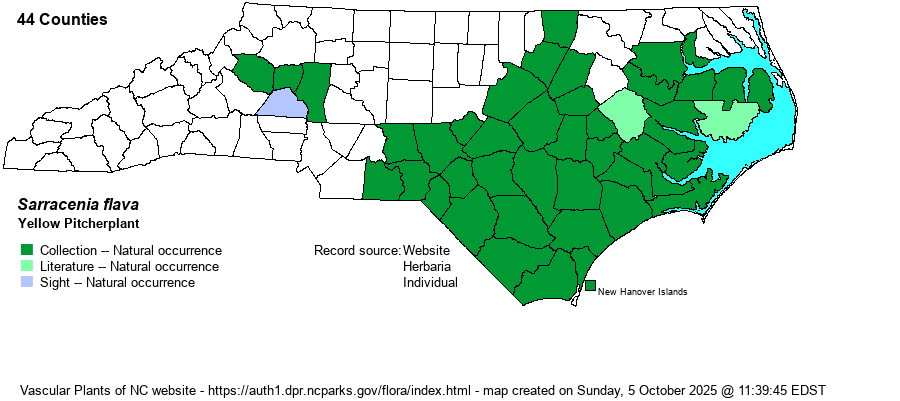| Author | L. | |
| Distribution | Occurs nearly throughout the Coastal Plain, though essentially absent in the extreme northeastern counties. Though it does occur sparingly in southeastern VA, it is a bit surprising that it has been recorded from just one county (Chowan) north of Albemarle Sound and the Roanoke River. Formerly it was found at a few sites in the extreme eastern edge of the Piedmont, but it is nearly extirpated there now. It also was found in a handful of boggy sites in the western Piedmont (Iredell, Catawba, Alexander, and Caldwell counties), though apparently only Iredell County might still contain a few plants. Thus, the species is nearly restricted to the Coastal Plain now. There are a number of SERNEC specimens from additional counties, and though the species is difficult to mis-identify, none of these specimens have online images owing to "Protected" status from SERNEC.
This is a classic Southern Coastal Plain species, found from southeastern VA south to northern FL and west to AL and southeastern MS. | |
| Abundance | Still locally common in some places in coastal counties, but clearly declining and now mostly rare to uncommon in most counties away from coastal ones. It can be common in the center of some pocosins and Carolina bays, and can be fairly common to common in some well-managed nature preserves. Uncommon and local now in the Sandhills region, and extremely rare now in the Piedmont. | |
| Habitat | Like all "carnivorous plants", it is found only in wetlands, being most numerous in pine savannas, especially in the wetter portions, including in ditches and scrapes within or near savannas. It also is found in open areas within pocosins and bays, particularly wet enough to suppress the growth of many woody species. In the Sandhills and Piedmont, it grows mostly in seepages, such as along the ecotones between sandhills vegetation and streamhead pocosins. |
| Phenology | The pitcherplants are spring blooming species, this one being in flower mainly from March to early May. It sets fruits in May and June. | |
| Identification | This is the largest and most visually striking species of pitcherplant in the state. It has one to several tall and erect leaves, each being a pitcher that is tubular in shape and widening toward the top, growing to about 2 feet tall, but at times close to 3 feet tall. The apex or hood is a flattened "top" to the pitcher, raised above the opening of the pitcher a few inches by a narrow stalk. In spring, the plant sends up a tall flowering stalk, separate from the pitchers; this stalk grows nearly as high as the top of the pitchers. The single flower is huge and nodding. It consists of a broad yellow disk that supports the five large, bright yellow, drooping petals, each being 2-3 inches long. This flower "head" is roughly the size of a baseball. Soon after flowering, these petals drop off, but the yellow disk remains, and many people think that this yellow disk, hanging on for a few months, is actually a flower in bloom. As the leaves remain well into the fall season, this species can normally be identified by them alone. Sarracenia rubra may grow with S. flava and it has similar trumpets, but it is a smaller species, often just 1-1.5 feet tall, the hood is usually less than 1-inch across, and it has maroon flowers. Note that the fairly recently described S. oreophila occurs in the southwestern mountains (Clay County). It looks very similar to S. flava, with bright yellow flowers, but it has many phyllodia (non-pitcher leaves) at the base, and these are strongly curved; S. flava either lacks phyllodia or they are few per plant and straight to gradually curved. Their ranges do not come close to each other in NC. Sarracenia minor has light yellow flowers but the pitcher is strongly curved at the apex to form a hood. | |
| Taxonomic Comments | Older references frequently listed varieties for this species; however, Weakley (2018) does not consider them valid.
| |
| Other Common Name(s) | Trumpets is another frequently used name. However, it is best to attempt to name all Saracenia species as "xxxx Pitcherplant", if such a name is available in the literature. Though other species in the genus do have yellow flowers, S. flava is the most common and widespread of them and this most frequently used name of Yellow Pitcherplant has stuck with most references. | |
| State Rank | S3S4 | |
| Global Rank | G5? | |
| State Status | | |
| US Status | | |
| USACE-agcp | OBL link |
| USACE-emp | OBL link |

